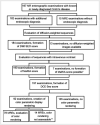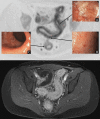MR Enterography in Crohn's Disease: Comparison of Contrast Imaging with Diffusion-weighted Imaging and a special Form of Color Coding
- PMID: 35705164
- PMCID: PMC9576345
- DOI: 10.1055/a-1826-0049
MR Enterography in Crohn's Disease: Comparison of Contrast Imaging with Diffusion-weighted Imaging and a special Form of Color Coding
Erratum in
-
[Erratum: MR Enterography in Crohn's Disease: Comparison of Contrast Imaging with Diffusion-weighted Imaging and a special Form of Color Coding].Rofo. 2022 Oct;194(10):e2. doi: 10.1055/a-1918-8351. Epub 2022 Oct 4. Rofo. 2022. PMID: 36323405 Free PMC article. German. No abstract available.
Abstract
Purpose: We compared contrast-enhanced MR enterography with diffusion-weighted sequences to evaluate the validity of diffusion-weighted sequences for activity assessment in Crohn's disease compared to endoscopy. In addition, we investigated a new color-coded image post-processing technique in comparison with standard sequences and endoscopy.
Materials and methods: Included were 197 MR enterographies (2015-2017) performed by using standardized examination protocols. The intestine was divided into 7 segments, which were compared separately. The accuracy of the MR examinations with regard to disease activity was validated using the Seo and MaRIA score and endoscopy findings. In addition, the image data were post-processed using a color-coded evaluation method (DCE tool on OsiriX).
Results: The comparison between contrast-enhanced and diffusion-weighted sequences showed a highly significant correlation for all bowel sections with a mean Spearman correlation coefficient of 0.876 (0.809-0.928). The color-coded image post-processing showed a sensitivity of 83.2 % and a specificity of 70.5 % in comparison with the MaRIA score. In comparison to endoscopy, a sensitivity of 81.3 % and a specificity of 70.5 %. In comparison with endoscopy, the MaRIA score showed a sensitivity of 80.2 % and a specificity of 84.0 % at a cut-off of 7. The visual score according to Seo showed a sensitivity of 85.7 % with a specificity of 77.0 % in the contrast-weighted examination and a sensitivity of 87.9 % and a specificity of 71.8 % for diffusion weighted images.
Conclusion: Diffusion-weighted sequences are as good as contrast-weighted sequences for assessing inflammatory activity in Crohn's disease. Contrast is often helpful for assessing complications, but this was not the purpose of this study. Visual imaging using color-coded data sets was similarly good at detecting inflammation.
Key points: · MR enterography is possible without contrast using diffusion-weighted imaging with comparable high informative value.. · Inflammatory activity in MR correlates sufficiently well with endoscopy. · The MaRIA and Seo scores are comparable in their validity.. · The colored representation of inflamed bowel sections is a promising technique..
Citation format: · Jakob M, Backes M, Schaefer C et al. MR Enterography in Crohn's Disease: Comparison of Contrast Imaging with Diffusion-weighted Imaging and a special Form of Color Coding. Fortschr Röntgenstr 2022; 194: 1119 - 1131.
Vergleich der entzündlichen Aktivität verschiedener Darmabschnitte in der kontrastmittelgestützten MR-Enterografie mit diffusionsgewichteten Sequenzen und dem endoskopischen Befund. Eine neue farbcodierte Bildnachverarbeitung wurde im Vergleich zu den Standardsequenzen und der Endoskopie untersucht.Eingeschlossen wurden 197 MR-Enterografien aus den Jahren 2015–2017. Der Darm wurde in 7 Segmente unterteilt, die separat verglichen wurden. Die Treffsicherheit der MR-Untersuchungen bezüglich entzündlicher Darmwandveränderungen wurde mittels Endoskopie sowie Seo- und MaRIA-Scores validiert. Zusätzlich wurden die Bilddaten mithilfe eines farbcodierten Auswerteverfahrens (DCE-Tool auf OsiriX) nachverarbeitet.Der Vergleich zwischen kontrastgestützten und diffusionsgewichteten Sequenzen ergab für alle Darmabschnitte eine hochsignifikante Korrelation mit einem mittleren Korrelationskoeffizienten nach Spearman von 0,876 (0,809–0,928). Die farbcodierte Bildnachverarbeitung zeigte im Vergleich mit dem MaRIA-Score eine Sensitivität von 83,2 % und eine Spezifität von 70,5 %. Im Vergleich zur Endoskopie fand sich eine Sensitivität von 81,3 % und eine Spezifität von 70,5 %. Der MaRIA-Score zeigte im Vergleich mit der Endoskopie beim Cut-Off von 7 eine Sensitivität von 80,2 % bei einer Spezifität von 84,0 %. Der visuelle Score nach Seo zeigte bei der kontrastgestützten Untersuchung eine Sensitivität 85,7 % bei einer Spezifität von 77,0 %, bei der diffusionsgewichteten Sequenz eine Sensitivität von 87,9 % und einer Spezifität von 71,8 %.Diffusionsgewichtete Sequenzen sind zur Beurteilung der Entzündungsaktivität bei Morbus Crohn ebenso gut geeignet wie kontrastgestützte Sequenzen. Zur Beurteilung von Komplikationen ist eine Kontrastmittelgabe oft hilfreich. Die Darstellung mittels farbcodierter Datensätze konnte Entzündungen ähnlich gut nachweisen und könnte die Befunddemonstration in der interdisziplinären Zusammenarbeit verbessern helfen. · Die MR-Enterografie ist auch ohne Kontrastmittel mittels diffusionsgewichteter Bildgebung mit vergleichbar hoher Aussagekraft möglich.. · Die Entzündungsaktivität in der MRT korreliert ausreichend gut mit dem endoskopischen Befund.. · Die verwendeten Scores MaRIA und Seo sind in ihrer Aussage vergleichbar.. · Die farbige Darstellung entzündeter Darmabschnitte kann eine rasche Einschätzung der regionären Verteilung einer Crohn-Manifestation ‚auf einen Blick‘ erleichtern und könnte die Befunddemonstration in der interdisziplinären Zusammenarbeit verbessern.. · Jakob M, Backes M, Schaefer C et al. MR Enterography in Crohnʼs Disease: Comparison of Contrast Imaging with Diffusion-weighted Imaging and a special Form of Color Coding. Fortschr Röntgenstr 2022; 194: 1119 – 1131.
The Author(s). This is an open access article published by Thieme under the terms of the Creative Commons Attribution-NonDerivative-NonCommercial License, permitting copying and reproduction so long as the original work is given appropriate credit. Contents may not be used for commecial purposes, or adapted, remixed, transformed or built upon. (https://creativecommons.org/licenses/by-nc-nd/4.0/).
Conflict of interest statement
The authors declare that they have no conflict of interest.
Figures
































References
-
- Schreyer A GLD, Koletzko S, Hoffmann J C et al.Aktualisierte S3-Leitlinie zur Diagnostik des M. Crohn – Radiologische Untersuchungstechniken. RöFo. 2010;182(02):116–121. - PubMed
MeSH terms
Substances
LinkOut - more resources
Full Text Sources
Medical

